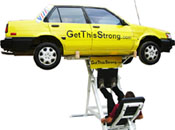|
Pete Sisco Interview - The World's Fastest Workout P ublisher and author Pete Sisco is the developer of The World's Fastest Workout - an ultra-brief method of muscle building called Static Contraction Training.Pete has never been a pro or amateur athlete, nor even an athlete in school or college. Yet despite these humble origins, he famously went onto lift a 1987 Toyota Corolla! So how did Pete Sisco get so strong and easily lift a car that weighs well over a ton? Because of the way he trains. Dedicating himself to helping others improve their strength in the most effective way possible, Pete Sisco's training methods have featured in six titles published by McGraw Hill and in publications such as Men's Fitness, Flex, and Muscle & Fitness. We think you'll enjoy hearing what Pete has to say, so put down your protein shake and pull up a chair! An Interview with Pete Sisco1. Hi, Pete. It is estimated over 200,000 trainees have used your training methods - how did your Static Contraction story start?
I wrote down every exercise, weight, rep and set that I did and I timed all of it on my wristwatch. After every workout I transferred all the information onto my laptop while we ate hamburgers and yakked about life in general at a nearby restaurant. We both knew Mike Mentzer and respected his emphasis on 'high intensity training.' I studied math and physics and when the talk turned to intensity I wanted to know how it was measured and quantified. Nobody knew. There literally was no measurement being used. (Almost 20 years later, except for my training, there still isn't a measurement. The mind boggles.) Anyway, I used a simple measurement of the total weight lifted divided by how much time it took to lift it. Long story short, I called that measurement the Power Factor. Having meaningful numbers led to finding ways to increase the intensity of every exercise and that eventually led to Static Contraction. When you lift under ideal circumstances the absolute maximum weight you can hold for five seconds but no longer, it represents the highest intensity any muscle can generate. Do that on a progressive basis and great things happen.
Newton created the new world where people look to science and math for answers to mysteries and Watt pioneered the study and measurement of power. I'm serious about those influences. Newton has probably done more to improve my life (and everyone else's) than any single person I can name. Once science and experiment established that lifting heavy things builds muscles in humans, the rest is just the laws of mechanics. For me, that cuts right through 99% of the BS heard in gyms. If someone claims A is a better biceps exercise than B, I want to see measurements that prove it.
But people screw that up by going back to the gym too soon. They aren't any stronger so they do some dumb workout that hasn't a prayer of building new muscle. It's busywork. This is what happens to people who believe the 'Monday, Wednesday, Friday' nonsense. Who on earth can get stronger every 48 hours for months at a time? Maybe a young male jacking himself full of two grand a month in pharmaceutical help could do it. Nobody else can. But guess what days are always busiest at the gym? Sad and avoidable.
Engineers understand objective measurement. They know that when you deviate away from your goal you have to make adjustments in your tactics. When people train with Static Contraction or Power Factor they are writing down their performance. Power Factor uses spreadsheets to create graphs so you can see success and failure. Engineers get that.
I didn't get smart until my early thirties. Like most people, my visits to the gym didn't do a thing to transform me. It was only after 1992 when I started measuring everything that I got really strong. I was amazed at what I could lift. I once lifted a total of one million pounds in just over two hours. It worked out to something like three and a half TONS every minute for over two hours. And I was a guy with an office job who visited the gym maybe three times a month.
The big future for static contraction will come when a proper static contraction home machine is available. Having a simple machine that uses no weight plates or stacks yet offers literally tons of resistance, records digital measurements of 10 or 20 strength parameters will revolutionize strength training. That can't come soon enough for me. Nearly every gym today uses machines that could have been build with 1850's technology. I'm serious about that. Take a look at the next machine you use for an exercise and ask yourself what component of it was not available at the time of the steam engine. It's sad how primitive strength training is in this century. And shameful how many people want to keep it that way for their own financial benefit at the expense of other's health and wealth. Thanks for interviewing me, Lee. Train Smart, Pete Sisco Thank you for your time, Pete. Our readers at Ordinary Joe Muscle Building wish you every success! Click here to discover The World's Fastest Workout |





